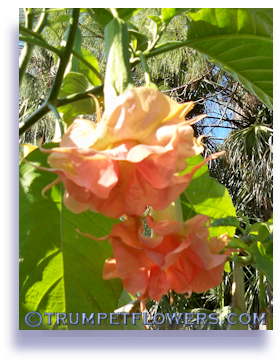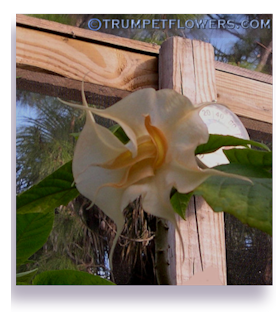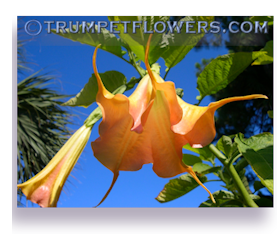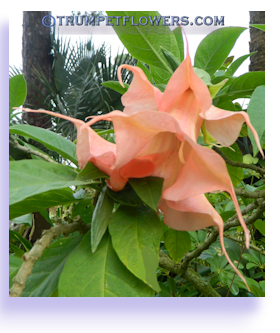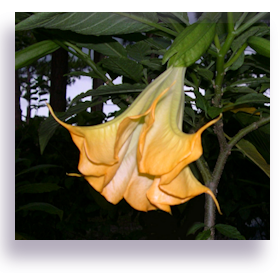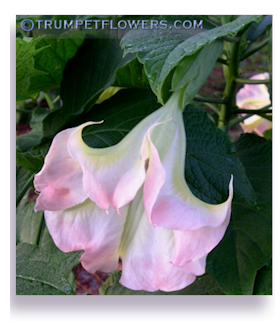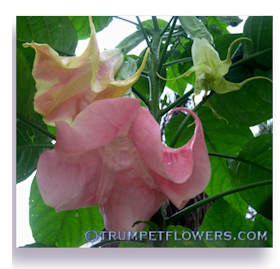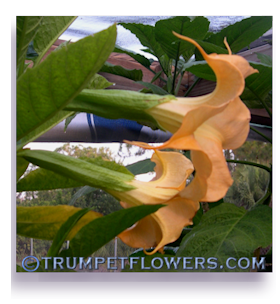Water, The Lifeblood
of Your Garden
Water
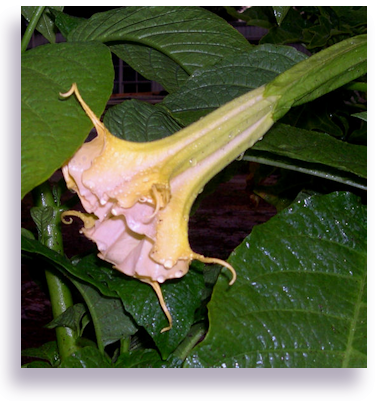 Of course, your Angel's trumpets must have water, as do all plants. Almost all brugmansia love water (in excess it would seem), and some cultivars actually need to be watered twice a day. You can always tell if you have one of these...the leaves will slightly wilt in midday sun. Not to worry, just give it a nice long drink and within 15 minutes to half an hour the plant will perk right back up.
Of course, your Angel's trumpets must have water, as do all plants. Almost all brugmansia love water (in excess it would seem), and some cultivars actually need to be watered twice a day. You can always tell if you have one of these...the leaves will slightly wilt in midday sun. Not to worry, just give it a nice long drink and within 15 minutes to half an hour the plant will perk right back up.
I have found that mine aren't that particular, but there are a few things one must take into consideration when considering water source for angel's trumpets. However, I do not tolerate sulfur or chemicals when watering them. I find that making sure the water is as pure as I can get it does create a healthier plant all∼around.
- 1. Chlorinated Water
- 2. Well Water
- 3. Hard Water
- 4. Rain Water
Chlorinated Water
Chlorinated water is tap water. Tap water is fine for use, but after a while the chlorines and other additives the city puts in may build up in potted brugs and cause the plantsome stress. Signs of stress are yellowing leaves, weakened stems and trunk, and spotting on the leaves. Some of these signs could also be caused by the plant not receiving enough sun,but if you are sure your angel's trumpet is receiving proper sunlight, the culprit could well be the chemicals in the city tap water.
To get rid of them, you'll need to 'flush' them out of the soil. There are a couple of ways to do this. The first method is the cheapest and easiest. First, if you have a garden hose connected to your outdoor dwelling, check to see if it runs to city water. In some cases, it is not. If you are in a newer neighborhood, it probably is.But if by chance you live in an older home, or are further out towards countryside, you may have well water or cistern water coming through the garden hose. Use this tocompletely flush all the built up salts and chemicals in the pot with the ailing brugmansia. Let the water run through for a good 5 minutes or so, to be sure you got rid of the buildup.
The second method is more time consuming, but also has better results. If you have a rain barrel system set-up, use water from this to flush the soil.
You could also use bottled water, but that gets very pricey and fast. If you possibly can, see about saving some rain water in large buckets the next time a thunderstorm threatens.That is, if you don't have the rain barrel system.
Well Water
Well water will contain no chlorine or ammonia, as treated tap water does. Depending upon where you live, it may be as good as rain water. Unfortunately, the way big cities and big business works, water is usually the first thing polluted by us, as use as a cleansing sytem to all we manufacture, recycle, and as refuse/waste cleanser. Some people also have a nasty habitof dumping old prescriptions into the toilet, which finds it's way into your well water. There are a million different things that can be in well water, and not good things either.Not to sound dark, just stating the facts.
Since brugmansia is an ornamental, and not to be eaten, this can be alright as long as certain toxic chemicals are not present. If you have good results with well water on your other plants, then it will be fine for the angels.
Sulfur is one of those things that can be found in many ground water wells throughout the country. You'll know if it's present in large amounts just by the smell it gives off. A nasty, rotten egg smell will be detectable. It's not so bad when first using it. As a matter of fact, it will seem as though your plants enjoy it at first. But after using it about 6 weeks to a couple of months, the brugs (and other plants) begin to suffer. A thin, slimy green film may also appear on the tops of the pots your plants reside in. This invites fungus gnats and other plant pests. It also stops oxygen from entering the soil via the surface, which chokes your prized Angel's trumpets.
The smell is created by the presense of bacteria that may be present in the conjunction with iron in the water. These bacteria are anaerobic... meaning they do not like the presense of oxygen. Most anaerobic bacteria are not good. Without getting too technical, their counterparts, the aerobic bacteria thrive in the presense of oxygen in the water, and are used to maintain perfectly balanced fresh and saltwater aquariums.
You can treat it in batches yourself. Depending upon how many plants you will need to be watering will also dictate how big of a tub you will need to treat water with the sulfur bacteria. The larger the batch, the better, as the water becomes better with age. Buy or use a pre∼exsisting plastic laundry tub. Using only Clorox bleach that has no added perfumes, use 1.25 quarts per 100 gallons of well water. (3/4 of a quart for 50 gallons) Swirl it into the water very well, using a discarded broomstick or something similar. Now allow the water to rest at least 24 hours before using it. 48 hours is even better. During this time the chlorine will do it's work, and then release as a harmless gas into the atmosphere. Cover the laundry tub to save any treated water for other waterings.
If you are close to an electrical source and want to use the water quicker, buy a small air pump like those used for fishtanks and attach an aerator stone to the tubing. Anchor it into the tub after it has been allowed to sit with the chlorine in it after about 4 hours. This will allow the chlorine to escape the water sooner, and give you the added benefit of aerated water for your plant's roots.
Hard Water
You may have hard water. This means it contains a lot of minerals. Some minerals are good for some plants, but too many over an extended period of time allows them to build up and it becomes bad for the same plants. You can counteract them quickly with the addition of Borax to your plant water source. Using the same ideal as above, get a large plastic laundry tub and fill it with the offending water. Add powdered Borax (found near the clothes detergent in supermarkets) in the amount of 1 to 1 1/2 tbsp. per large laundry tub. Swirl it into the water very well, making sure it dissolves. Allow it to rest in the water 24 hours. Strain off the top water when you begin to use it, allowing any sediment created to lie on the bottom of the tub.
A Note of Precaution using Borax
Borax adds salt to the water in order to 'soften' it, or remove the minerals. Since plants need calcium and magnesium, softening it too often is not good for the plants either. Only soften the water with the addition of borax once every 4 to 6 months. Before using the borax treatment, flood the planter well with a clean water source to ensure you have no extra buildup of salts. Borax is good for plants, if it is not overused. If you use too much, it breaks the osmosis cycle within the soil via the plant's root system, and could damage them.
Rain Water
This is your best bet for watering brugmansias, as well as many other plants. Rain water seems to perk up ornamentals and vegetables alike, within an hour of a good summersoaking rains their leaves point closer to the heavens, as if to rejoice in nature's own cleansing mechanism∼filtered by cloud rainwater.
If you have the space, it is well worth it to set up a rain barrel or other method of catching rain water. A Rainbarrel system works off of your home's exsisting gutters,trapping the rain that fell on the roof and storing it for later use. If these gutters are metal, there will be ppm of metal also now in the rainwater, which would not have been present in just the rainwater itself. It is fine for the plants. I use them constantly. I also use an open ground method that traps thje rains directly from the skies in a large plastic containerset well above my height so as to create water pressure to the attached spigot and garden hose. Either method works very well.
When using rainwater, it is minus minerals that the plants need. You will have to be sure to fertilize and add the trace elements the angel's trumpets will need back to the soil in order to have a completely healthy plant.

As important as all of the discussion on different water types, is the importance of not overwatering your plants. They must be allowed to dry out slightly between waterings. This allows all important oxygen to enter the root systems, and lets beneficial bacteria and other soil building life forms there breathe as well. It also helps curb fungal outbreaks. So remember, choose the right water, but do not over do it. Overwatering is as harmful as no water at all.

Tags: water for the garden, watering trumpetflowers, watering angel trumpet, water for brugmansia, angels trumpets, trumpet flowers, brugmansia, solanaceae, grow brugmansia,
This entry was posted on March 22nd, 2012 and is filed under Water for the Garden.
